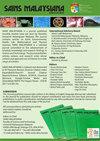基于网络药理学的Lupenone对1型糖尿病大鼠的降糖作用及其机制研究
IF 0.7
4区 综合性期刊
Q3 MULTIDISCIPLINARY SCIENCES
引用次数: 0
摘要
据报道,Lupenone具有许多药用价值,并具有积极的抗糖尿病作用。但在1型糖尿病大鼠中防治1型糖尿病的机制尚未阐明。本研究通过网络药理学和糖尿病大鼠实验研究了豆酮对1型糖尿病的防治作用及机制。测定1型糖尿病大鼠胰腺血糖、糖化血红蛋白(HbA1c)、胰岛素及炎症因子水平,观察lupenone治疗后胰腺组织病理变化。构建了糖尿病大鼠“组分-靶点-疾病”药理网络。基因功能富集、京都基因与基因组百科全书通路分析和分子对接。结果表明,lupenone可降低胰腺空腹血糖和HbA1c水平,升高胰岛素含量和白细胞介素(IL)-4、IL-10,降低IL-6、转化生长因子β和肿瘤坏死因子α水平。通过网络药理学方法,鉴定出10个靶点,筛选出50条与1型糖尿病和炎症密切相关的信号通路,包括胰岛素抵抗、II型糖尿病、I型糖尿病、胰岛素信号通路、丝裂原活化蛋白激酶(MAPK)信号通路、肿瘤坏死因子(TNF)信号通路。潜在靶点与lupenone的对接亲和力在-3.3 ~ -9.8之间,其中caspase-3 (CASP3)、cyclin依赖性激酶4 (CDK4)、kappaB激酶β抑制剂(IKBKB)、转化生长因子β -1 (TGFB1)、TNF具有较高的结合能力。因此,作为一种治疗1型糖尿病的新药,lupenone具有开发潜力。本文章由计算机程序翻译,如有差异,请以英文原文为准。
Exploring the Antidiabetic Effect of Lupenone in Rats with Type 1 Diabetes and its Underlying Mechanism Based on Network Pharmacology
Lupenone has been reported to possess numerous medicinal values and gives a positive antidiabetic effect. But the mechanism of preventing and treating type 1 diabetes has not been elucidated in type 1 diabetic rats. This study investigated the effects and mechanism of action of lupenone in preventing and treating type 1 diabetes by network pharmacology and diabetic rats. The blood glucose, glycosylated hemoglobin (HbA1c), insulin, and inflammatory factors in the pancreas of rats with type 1 diabetes were measured, and histopathological changes were observed after treatment with lupenone. The pharmacological network of ‘component-target-disease’ was constructed on diabetic rats. Gene function enrichment, the Kyoto Encyclopedia of Genes and Genomes pathway analysis, and molecular docking were performed. The results showed that lupenone can decrease fasting blood glucose and HbA1c levels, increase insulin content and interleukin (IL)-4, IL-10, and decrease IL-6, transforming growth factor β and tumor necrosis factor α levels in the pancreas. Furthermore, ten targets were identified, and 50 signal pathways closely related to type 1 diabetes and inflammation were screened by network pharmacology, including insulin resistance, type II diabetes, type I diabetes, insulin signal pathway, mitogen activated protein kinase (MAPK) signal pathway, and tumor necrosis factor (TNF) signal pathway. The docking affinity of potential targets and lupenone were between -3.3 and -9.8, among which caspase-3 (CASP3), cyclin-dependent kinase 4 (CDK4), inhibitor of kappaB kinase beta (IKBKB), transforming growth factor beta-1 (TGFB1), and TNF had high binding abilities. Thus, lupenone has the potential to be developed as a new drug for treating type 1 diabetes.
求助全文
通过发布文献求助,成功后即可免费获取论文全文。
去求助
来源期刊

Sains Malaysiana
MULTIDISCIPLINARY SCIENCES-
CiteScore
1.60
自引率
12.50%
发文量
196
审稿时长
3-6 weeks
期刊介绍:
Sains Malaysiana is a refereed journal committed to the advancement of scholarly knowledge and research findings of the several branches of science and technology. It contains articles on Earth Sciences, Health Sciences, Life Sciences, Mathematical Sciences and Physical Sciences. The journal publishes articles, reviews, and research notes whose content and approach are of interest to a wide range of scholars. Sains Malaysiana is published by the UKM Press an its autonomous Editorial Board are drawn from the Faculty of Science and Technology, Universiti Kebangsaan Malaysia. In addition, distinguished scholars from local and foreign universities are appointed to serve as advisory board members and referees.
 求助内容:
求助内容: 应助结果提醒方式:
应助结果提醒方式:


